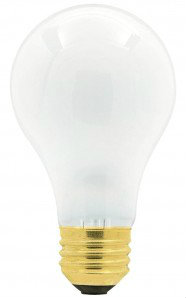|
When legislation went into effect (2012 to 2014) that basically banned the traditional incandescent light bulb, some people might have been confused to still see incandescent bulbs on store shelves. What might have been even more confusing was learning that a 43 watt bulb could suddenly replace a 60 watt bulb. And it suddenly cost a little more than they were used to spending on light bulbs. What was the deal? What was the new light bulb legislation about, and how were stores still selling incandescent bulbs? The Light Bulb Legislation First, the new legislation didn't ban incandescent light bulbs. Signed into law in 2007, the legislation didn't ban any specific bulbs or technology, but demanded that general use light bulbs (40 watt to 100 watt) meet new efficiency requirements. They had to produce a certain amount of light for each watt of energy used. And sadly, the beloved incandescent bulb -- inherently inefficient (most of its energy is released as heat) -- didn't meet the standards. But there was a "new," more efficient incandescent bulb available as the legislation went into effect. A new bulb that, in fact, had been around since the 1950s. It was called a halogen bulb. Now let's also be clear that the legislation didn't stop the sale of inefficient incandescent light bulbs. They just couldn't be made or imported in the USA. So for a while, you'd still see the old bulbs on shelves. And while they last, you can still get them from Lighting Supply. You'll also be able to continue buying other types of incandescent light bulbs that weren't phased out through this legislation. Halogen Light Technology As the general use incandescent bulbs were phased out, halogen lights began replacing the old bulbs and selling alongside CFLs and the newest technology, LED light bulbs. Again, halogen technology has been around for decades. Since it uses a filament that "incandesces" to produce light, its bulbs are still incandescent bulbs. They're made much like other incandescent bulbs, but there are some additional halogen gases inside the bulb, and the gasses are under higher pressure -- which means that the bulb itself has to be made stronger. In fact, the bulb is often made of fused quartz, which is why these are also sometimes known as quartz halogen bulbs. Halogen technology allows incandescent bulbs to burn more efficiently, producing about the same amount of light on nearly 30% less energy. This is why these bulbs began replacing old incandescent bulbs when the legislation went into effect. From the user's perspective, there's one small difference between traditional incandescent and halogen light bulbs. Many people love the "warm" (yellow) glow of an incandescent light bulb. It's why some hoarded these bulbs before the bulbs disappeared. Halogens have a similar look, but they burn a little "whiter" to the eye. Not a big difference, but worth noting. There's one more difference that affects the use of some halogens. This is because halogen bulbs burn very hot. Even hotter than traditional incandescents. So in the case of mini halogens and projection bulbs, you don't want to touch these bulbs with your hands, as this can leave oil residue on the bulb. This can cause oily / non-oily parts of the bulb to heat up differently, which can weaken and eventually break the bulb. Wear gloves when installing these bulbs. This doesn't likely apply, however, to general use halogen bulbs. The Shapes and Applications of Halogen BulbsHaving been around for decades, and long before LED technology became popular, halogen technology has found its way into a wide array of light bulbs to serve different applications. Besides lamps for general lighting and PAR shaped floodlights, halogen lights can be found in vintage cars, projectors, and stage lighting, and are even used as indicator lights. They come in a variety of shapes, including miniature bulbs, single and double-ended halogen lamps, and MR16 halogens, often used in track lighting and display case lighting. On that note, we should point out that halogen lights have a high CRI -- they rate roughly 100 out of 100 on the Color Rendering Index. Because of this, they're commonly used in product displays. They do a great job at this, but in applications where the heat from the halogen is a problem (think about perishable food or museum settings), high CRI LED lights can be a terrific substitute.
In the end, there's nothing so new about halogens, except that they've been newly discovered by many people. They've been a reliable lighting source for decades and are widely used, now in many more households than they used to be. But with the era of LED lights upon us, many halogens are being upgraded to the lower temperature, higher efficiency, and longer lifespan of LEDs. Still, with their lower initial cost, high CRI, and incandescent familiarity, halogens can be a great lighting choice for some time to come.
0 Comments
Your comment will be posted after it is approved.
Leave a Reply. |
This blog's content is copyright © 2014-19 Lighting Supply.

